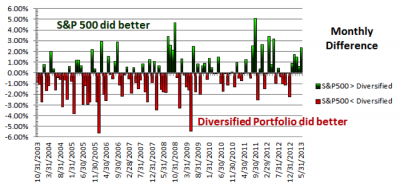The financial headlines are exciting these days. The S&P 500 added a whopping 11.4% in 2014. Nasdaq was up by 11%. And the DOW jumped 7.5%.
With these great numbers blaring at you from the bright lights of the news media, you might be asking: “Why aren’t my numbers looking so impressive? What am I doing wrong?”
The fact is, unless you’re willing to bet your portfolio on high-risk, short-term returns, if your portfolio delivered a relatively modest sounding after-inflation return of 3-4% in 2014, it’s likely you’re doing everything right. Here’s why:
A balanced portfolio of 60% stocks and 40% bonds delivers a much more reliable return on investment than 100% stocks. There may not be any fireworks when you see that single-digit number, but remember that the goal is to achieve a solid long-term return—after tax, after inflation, and after fees—all at a reasonable risk based on your long-term financial goals. A well-balanced, diversified portfolio includes four major asset classes, with varying percentages depending on your personal financial goals, time horizon, and other key factors. These four components are:
-
Domestic large-cap equities
-
Domestic mid-cap, and small-cap equities
-
International equities (including global stocks in developed and emerging markets)
-
Fixed-income securities (including bonds)
While it’s true that domestic caps performed undeniably well last year, history tells us that maintaining a careful mix of these four key components (with the riskier equities category decreasing in weight as the time horizon decreases) can decrease risk substantially and deliver a more predictable return over the long term. When comparing a strict S&P 500 to a sample diversified portfolio over a nearly 10-year period from October 2003 to May 2013, the diversified portfolio earned an extra 2.9% annually—at substantially less risk than the equities portfolio.

(Source: Diversification: Why Not Put Everything in Whatever Will Go Up the Most?, Forbes, July 2013)
Hedge funds are a good example of the more risky approach, and there’s a good reason these funds aren’t delivering their touted too-good-to-be-true numbers these days too. Known for their inconsistent (but sometimes high-flying) returns, hedge funds averaged a return of just under 3% in 2014. Just like betting on that long shot at the racetrack, hedging the market is a tricky game—and the more volatile the market is, the trickier the game becomes.
It’s difficult to look away from the thrilling numbers of the major benchmarks— the S&P 500, Nasdaq, and the Dow—in 2014, but it’s important to remember that these highly publicized indexes don’t account for the not-so-little details of taxes, fees, commissions, and inflation, so the actual return to a portfolio isn’t quite what it seems (and really, is anything ever quite what it seems?!). And while the S&P 500 is one of the most watched indicators of performance for large cap equities, it includes only 500 stocks from more than 15,000+ to choose from. These 500 stocks are certainly representative of the overall market, but historically, the S&P has outperformed international developed and emerging-market stocks only three times since 2000, and it outperformed domestic midcap and small-cap stocks only once since 2000. While a $2 Million portfolio invested only in the S&P 500 in 2014 would have gained $228,000, that same portfolio would have lost more than $1.1 million during the great bear market of October 2007 to March 2009. That’s a level of volatility that even the most seasoned risk taker may find difficult to stomach.
Few anticipated such stellar returns on the S&P 500 last year. Perhaps even fewer anticipated the S&P 500’s 38% decline in 2008. If you really are a risk taker—and you’re willing to bet you financial future on the potential of cashing in on the long shot—you may get a good thrill from throwing your savings at the benchmarks. If you’re really, really lucky, you may see a fireworks-worthy return on your investment.
As for the rest of us? We’ll keep moving forward and striving for that nice, comfortable 3-4% each year after inflation, fees and expenses. Our nerves will benefit greatly, and my guess is that our retirement cash flow will be that much more comfortable when the time comes as well.
Is it time to explore changes to your own portfolio?I’m here when you’re ready (just please don’t ask me to place all your bets on the long shots—I don’t have the fortitude).








